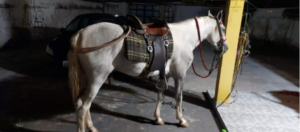CNN
—
In the week since a six-year-old boy in Newport News, Virginia took a gun from his home, brought it to school and shot his teacher, community members and officials are grappling with an unsettling question: How did the child get access to a loaded firearm?
“There’s a lot of questions that we have to answer as a community,” Newport News Mayor Phillip Jones told CNN, including “how a 6-year-old was able to have a gun (and) know how to use it in such a deliberate manner … The individuals responsible will be held accountable. I can promise that.”
Police are seeking answers as they investigate the events leading up to the January 6 shooting at Richneck Elementary school, wounding a 25-year-old elementary school teacher identified by officials as Abigail Zwerner. While her injuries were initially described as life-threatening, Zwerner has been listed in stable condition since Saturday, according to the city’s police chief, Steve Drew.
The boy, who was taken into custody immediately after the shooting, was under a temporary detention order and was being evaluated at a hospital, police said Monday. The gun allegedly used in the shooting was legally purchased by the child’s mother, who could face charges at the end of the investigation, Drew said.
It was the first shooting at a US school in 2023, according to a CNN analysis, highlighting what some gun policy experts believe is a dire need for stronger, more consistent laws nationwide, requiring adults to safely secure their guns out of the reach of children and others unauthorized to use them. It also reveals a lack of public education on the responsibility of gun owners to store their guns unloaded, locked and away from ammunition, the experts said.
Research shows child access prevention and safe storage laws are effective in reducing shootings among youth, according to a report released on Tuesday by the RAND Corporation, a public policy research organization. The report recommends states without such laws consider adopting them to reduce gun-related suicides, homicides and unintentional injuries and death among youth.
“Unsecured guns in homes and cars are fueling our much broader and much more prevalent gun violence issue in the US,” said Cassandra Crifasi, a professor at Johns Hopkins Bloomberg School of Public Health who studies the effects of gun policies.
“It’s important to frame the issue as not just keeping yourself and your family member safe in your home, but making sure that the guns you own don’t fall into the hands of people who shouldn’t have them and might use them to harm other people,” she said.
Many communities across the nation are familiar with the traumatic effects of school shootings, which have become exceedingly common in the US compared to any other country. In 2022, there were 60 shootings at K-12 schools, a CNN analysis found.
But school shootings by a suspect so young are relatively rare. According to the K-12 School Shooting Database, which tracks shootings in American schools going back to 1970, there have been three other cases in which the suspect was as young as six: in 2000, 2011 and 2021.
Still, every year, hundreds of children in the US gain access to firearms and unintentionally shoot themselves or someone else, according to research by Everytown for Gun Safety, a leading non-profit organization focusing on gun violence prevention. In 2022, there were 301 unintentional shootings by children, resulting in 133 deaths and 180 injuries nationally, Everytown data shows.
Last June, a one-year-old girl was fatally shot and another child was injured after an eight-year-old boy accidentally shot them while playing with his father’s gun in Florida. Escambia County Sheriff Chip Simmons said the father left his gun in a closet in the room in what he thought was a safe holster. Then in July, an eight-year-old boy was shot and killed in Arkansas by his five-year-old brother in what authorities believed was an accidental shooting.
There are key differences between child access prevention laws and safe storage laws, and the provisions of each vary widely from state to state.
Secure storage laws typically have criteria to designate how the gun must be stored – loaded, unloaded, or separated from ammunition. Child access prevention laws are more flexible, generally saying gun owners must not knowingly store their guns in a place where a child could gain access to them, according to Crifasi.
“It’s a little bit more of a flexible policy in that it might allow a gun owner to store a gun in a way that sort of best meets their needs,” said Crifasi. “As long as you don’t knowingly think a child could access that gun, then you’re not necessarily violating the law.”
“The problem with many child access prevention laws is that there isn’t enough clear guidance on how guns should be stored in a way that is safe and secure,” she added.
Twenty-three states and Washington, DC, have laws in place regarding firearm storage, while eight states have laws mandating owners secure their firearms, according to research by Everytown. Fifteen states and Washington, DC have child access prevention laws, which generally stipulate an individual will be held liable if they did not securely store a firearm accessed by a minor, according to Everytown.
More states are considering some form of secure storage legislation, and most recently, Illinois passed a law last year, requiring the Department of Public Health to develop and implement a safe gun storage public awareness campaign.
Under Virginia law, it’s a misdemeanor if an adult leaves a loaded, unsecured firearm in such a way it could endanger a child under the age of 14. The statute also says it is unlawful for a person to unknowingly allow a child under the age of 12 to use a firearm.
In some rare cases, parents of children who access guns in the family’s home are prosecuted. Last June, for example, a mother of three in Florida was charged with manslaughter after her two-year-old son got hold of an unlocked handgun and fatally shot his father in their home, CNN previously reported.
“Very rarely are people actually held accountable when someone who is unauthorized, like a child, gains access to their firearms and uses them to harm themselves or someone else,” Crifasi explained. “It’s exceedingly rare to see people charged and punished in some way with fines or even jail time.”
Research shows the most restrictive laws regarding secure storage or child access prevention are also the most effective, said Lois Kaye Lee, a pediatrician and the chair of the American Academy of Pediatrics Council on Injury, Violence and Poison Prevention.
States holding gun owners criminally liable for any violation are associated with decreased rates of firearm deaths in children under the age of 14, said Lee, who is one of the authors of the 2019 study.
“Some states are misdemeanors, like in Virginia, and in other states they are felonies. The penalties are different, the restrictiveness level is different, and that, at least in our study, appears to make a difference when looking at firearm deaths in children,” Lee said.
An essential factor in all gun safety laws, including secure storage and child access prevention, is public awareness and education about how guns should be stored safely, experts said.
“We don’t have any robustly funded public education campaigns so that the general public understands the risks of children being around unsecured firearms, and that is because of the politics around firearms,” said Annie Andrews, a professor of pediatrics at the Medical University of South Carolina and an expert on gun violence prevention.
As a pediatrician, Andrews said in recent years she has focused on making it more acceptable in her workplace to ask the parents of children during checkups if they have firearms in the home and if they are securely stored.
“We offer gun locks, free of charge, to parents who do say that they have firearms in the home that aren’t securely stored,” Andrews said. “So, it’s a team effort: pediatricians, school districts, public health departments and our lawmakers all have to work together to reduce the incidence of these tragedies.”
It is a natural part of a child’s development to want to learn from and explore their environment, which is why their parents or caretakers are responsible for ensuring their spaces are safe, said Dr. Kelsey Gastineau, a Nashville-based pediatrician and a public health researcher.
Gastineau is also an activist for the Be SMART program, a framework to help normalize conversations and educate adults about secure firearm storage. The campaign was launched in 2015 by Moms Demand Action, which has been fighting for gun safety measures since the 2012 Sandy Hook Elementary School shooting.
Volunteers for BE Smart have urged school boards in states such as Texas, California and Arkansas to enact secure storage notification policies. As of December, more than 8.5 million students “will live in a school district that requires schools to educate parents about the importance of secure firearm storage” in the 2023-2024 school year, according to a statement from the campaign.
“When these shootings happen, there’s so much despair, there’s so much tragedy and fear that can ripple across communities,” said Gastineau, “Giving people a place to go and look for something they can do is so important.”



